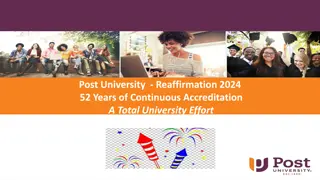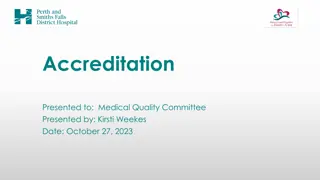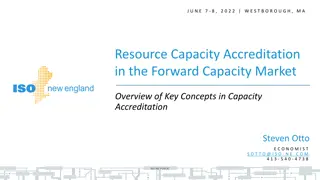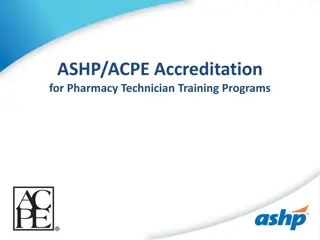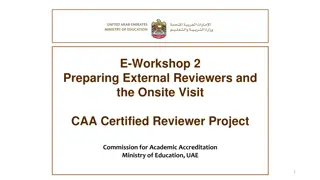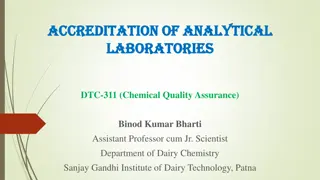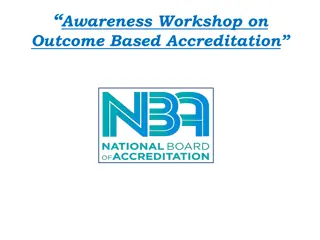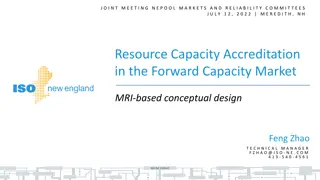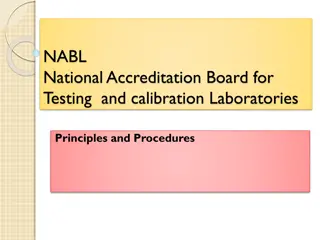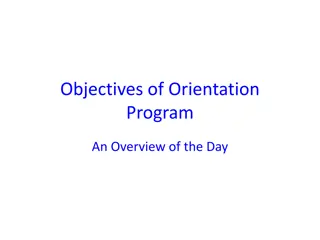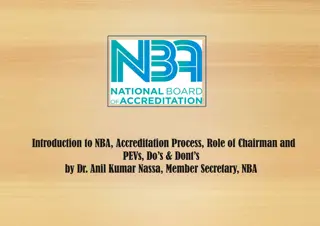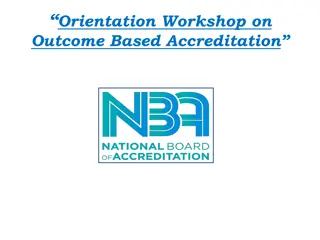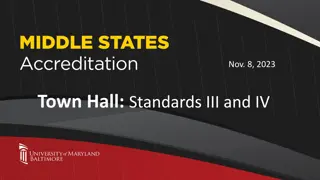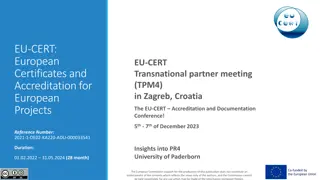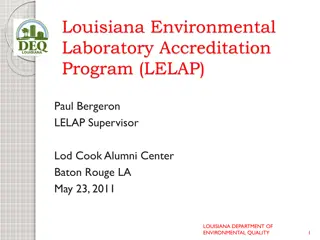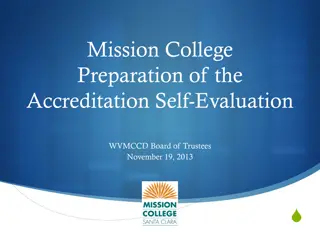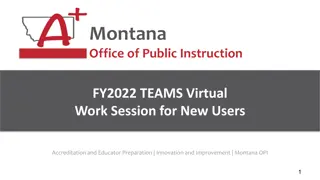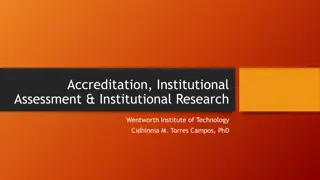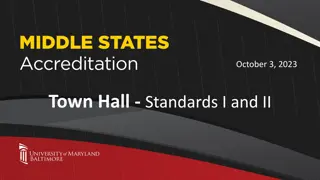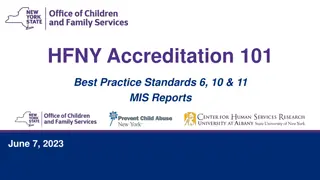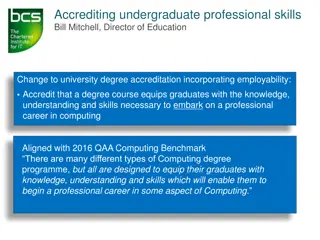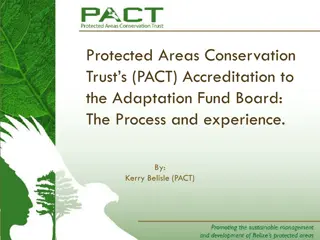
Accreditation Process and Institutional Overview
Accreditation is a voluntary system for evaluating educational quality and institutional effectiveness. Cañada College actively participates in this process, involving self-evaluation, external review, and continuous improvement based on set standards. The college's mission emphasizes equitable opportunities for student success, while its vision aims for academic excellence, diverse culture, and innovative programs. The college serves a student body of 6,700 with a dedicated faculty, staff, and administrators, all contributing to a participatory governance model.
Download Presentation

Please find below an Image/Link to download the presentation.
The content on the website is provided AS IS for your information and personal use only. It may not be sold, licensed, or shared on other websites without obtaining consent from the author. If you encounter any issues during the download, it is possible that the publisher has removed the file from their server.
You are allowed to download the files provided on this website for personal or commercial use, subject to the condition that they are used lawfully. All files are the property of their respective owners.
The content on the website is provided AS IS for your information and personal use only. It may not be sold, licensed, or shared on other websites without obtaining consent from the author.
E N D
Presentation Transcript
What is accreditation? Accreditation is a voluntary system of self-regulation developed to evaluate overall educational quality and institutional effectiveness. Accreditation is a regular self-evaluation of how well we are living up to the standards set by the Accrediting Commission for Community & Junior Colleges (ACCJC). An independent, external team of our peers (from other colleges) reviews our self-evaluation and visits our campus to determine if we are meeting the standards.
Where are we in the process? The review process includes four steps: 1. An internal self-evaluation DONE! 2. An external evaluation by a team of peer reviewers (September 30 - October 3, 2019) 3. Commission review and accreditation action (January, 2020) 4. An institutional response to recommendations for improvement (2020)
Mission Ca ada College provides our community with a learning-centered environment, ensuring that all students have equitable opportunities to achieve their transfer, career education, and lifelong learning educational goals. The College cultivates in its students the ability to think critically and creatively, communicate effectively, reason quantitatively, and understand and appreciate different points of view within a diverse community. Vision Ca ada College is committed to being a preeminent institution of learning, renowned for its quality of academic life, its diverse culture and practice of personal support and development, extraordinary student success, and its dynamic, innovative programs that prepare students for the university, the modern workplace, and the global community.
Students 6,700
Students 6,700 The Community
Faculty 220 Students 6,700 The Community
Staff 94 Faculty 220 Students 6,700 The Community
Staff 94 Faculty 220 Students 6,700 Administrators 24 The Community
Staff 94 Faculty 220 Students 6,700 Administrators 24 The Community
Participatory Governance How the College sets priorities and makes decisions
Students Faculty Staff Administrators Working Together for Student Success!
Administrators Staff Students Faculty
Participatory Governance Structure As of 11.7.18 SMCCD Board of Trustees Chancellor President Staff Cabinet Academic Senate (faculty) Classified Senate (staff) (VPs, all Deans, Marketing) PBC Admini- strators ASCC (students) Faculty Students Admini strators Admini strators Admini strators Staff Staff Staff APC SSPC IPC Faculty Faculty Students Students Faculty Students Key: = recommendations = decisions Programs Deans Program Review, Resource Requests, Staffing Requests College Mission
President Committee Reporting Structure As of June 25, 2019 Academic Committee for Equity and Success (ACES) Strategic Enrollment Management Committee Staff Report to the Planning & Budgeting Council (PBC) PBC Admin Faclty Academic Senate (faculty) Classified Senate (staff) ASCC (students) Studnts Curriculum Committee Subcommittee of the Academic Senate Administ rators Administ rators Administ rators Staff Staff Staff SSPC APC IPC Students Faculty Students Faculty Students Faculty Environmental Sustainability Committee Professional Learning Committee Safety Committee Report to the Administrative Planning Council (APC) Distance Education Advisory Committee Honors Transfer Program Committee Technology Committee Report to the Instructional Planning Council (IPC)
Accreditation Standards Standard I: Mission, Academic Quality and Institutional Effectiveness and Integrity Standard II: Student Learning Programs and Support Services Standard III: Resources Standard IV: Leadership and Governance
Planning & Budgeting How the College aligns its resources with its priorities and mission
Program Review PURPOSE: Program review is the process through which constituencies on a campus take stock of their successes and shortcomings and seek to identify ways in which they can meet their goals more effectively. A candid self-evaluation supported by evidence Guides internal decision making Provides external accountability (accreditation) Connects program review with the college mission, planning, and budgeting Faculty and Student Service Programs describes and documents what they do and why they do it Instructional Program Review is faculty led: at Ca ada the Academic Senate delegates process of peer review of program reviews to IPC SSPC facilitates the peer review of student services program reviews APC facilitates the peer review of administrative program reviews
Program Review Timeline December 1 Validation concludes; PRIE & Budget Office provide information and rubric to PBC for prioritization Dec - January President announces approved positions (contingent on funding) Oct. 30 Nov. 1 Position Justification Presentations Mid-April Late Jan Early Feb IPC Program Review Presentations August 1 Data Packets Available; TracDat Open Budget Office notifies Programs of approved requests funded for following year Divisions provide information about prior year grant funded positions Aug Oct. 10 Feb - April VPA presents budget scenarios to PBC November IPC, SSPC, APC & PBC give Peer Review feedback in joint meeting Departments conduct reviews Deans provide feedback August September October November December January February March April May October Cabinet reviews resource requests November Academic Senate prioritizes faculty position requests October 21 DUE Programs submit complete program reviews and all resource requests November 8 Deans, VPs and President submit prioritized Division or Department resource requests December 5 PBC prioritizes requests and presents President with prioritized list. Late March VPA & Deans discuss budget augmentation requests Mid-January VPA presents 3-year revenue and expense projections to PBC Mid-February VPA returns to PBC with funding proposal Early June VPA authorizes Divisions to make purchases August Flex Day Workshops Approved by PBC on February 6, 2019
Canada Ed. Master Plan Goals: Student Completion/Success To provide educational and student services programs that help students meet their unique academic goals; minimize logistical and financial barriers to success; and highlight inclusivity, diversity and equity. Community Connections To build and strengthen collaborative relationships and partnerships that support the needs of, reflect and enrich our diverse and vibrant local community. Organizational Development To invest institutional resources on the structures, processes and practices that focus on a diverse student and staff population, promote excellence, equity, inclusion and transformative learning.
Caada College Planning Calendar Year: 2017 2018 2019 2020 2021 2022 2023 2024 2025 2026 2027 Mid-Term Report ISER 2026 ISER 2019 ACCJC Annual, Mid-term, and ISER Report Cycle 5-year Education Master Plan Cycle 5-year Education Master Plan Cycle Annual Plan Annual Plan Annual Plan Annual Plan Annual Plan Annual Plan Annual Plan Annual Plan Annual Plan Annual Plan Distance Education Plan Facilities Master Plan Guided Pathways Plan Professional Learning Plan Research Plan Strategic Enrollment Plan Strong Workforce Plan Student Equity Plan Sustainability Plan Technology Plan
Measuring Effectiveness How the College knows if it s achieving its goals
Institution-set Standards: student achievement Institution- Set Standard Stretch Goal 2018-19 2017-18 2016-17 2015-16 2014-15 2013-14Six-year Data Element Definition of the Measure Average COLLEGE-WIDE STUDENT ACHIEVEMENT Applies to all students: successful course completion, grade C or better if graded, over the number of students enrolled when the general enrollment period ends: summer, fall, spring. Same as above - applies to studens who are enrolled at Ca ada College for the first time. This may include transfer students and students who had prior enrollment at other SMCCCD institutions. Summer, fall, spring. First Time Students enrolled in at least 6 credits in fall semester and enrolled in at least .5 credits in the subsequent spring semester. First Time Students enrolled in at least 6 credits in fall semester and enrolled in at least .5 credits in the subsequent fall semester. All Associate and Associate for Transfer degrees awarded by the College: summer, fall, spring. All Ca ada students who successfully transfer to a 4-year college or university: summer, fall, spring. Successful course completion rate (%) 70% 72% 72.9% 72.4% 72.0% 70.8% 70.2% 69.3% 72.9% Student success rates during their first year (First Time Students only) 62% 64% 69.6% 63.4% 68.5% 63.9% 63.6% 59.8% 69.6% Fall-to-spring persistence rate (First-Time Students only) 80% 82% 73.1% 75.7% 80.1% 75.2% 78.7% 77.1% 76.7% Fall-to-fall persistence rate (First-Time Students only) 64% 66% TBD 63.0% 61.8% 64.5% 65.5% 62.5% 63.5% Degree completion (total #) 300 380 754 558 585 486 463 422 545 Transfer (total #) 240 300 TBD 341 307 276 293 260 295 Based on UC and CSU data, all Ca ada students who successfully transfer to a UC or CSU: summer, fall, spring. UC/CSU Transfer # 150 170 TBD 305 243 217 217 193 235 All certificates awarded by the College: summer, fall, spring. Certificate completion (tot #) 280 300 310 372 292 244 332 400 325
Institution-set Standards: programmatic achievement Institution- Set Standard Stretch Goal 2018-19 2017-18 2016-17 2015-16 2014-15 2013-14Six-year Data Element Definition of the Measure Average PROGRAMMATIC STUDENT ACHIEVEMENT The number of students who passed the Radiological Technology National Exam over all who took the examination. Licensure Pass Rate: Radiological Technology 100% 100% TBD 100% 100% 100% 100% 100% 100% Job Placement (Radiology Technology only) The number of students who are employed in the year following their completion of the Rad Tech degree. 100% 100% TBD 100% 100% 92% 93% 88% 95% Successful course completion (as defined above) in Core GE courses which include: ANTH 110, ASTR 100, ASTR 101, BIOL 100, BIOL 110, BIOL 132, COMM 110, DRAMA 140, ENGL 100, ENGL 110, ENVS 115, GEOG 100, GEOL 100, GEOL 101, HIST 201HIST 202, HSCI 100, MATH 200, MUS 100, OCEN 100, OCEN 101, PHIL 100, PLSC 210, PLSC 310, PSYC 100, SOC 100 Successful course completion (as defined above) in courses taught 100% online (MIS: O) Successful course completion (as defined above) in CTE courses: SAM Code: A, B, and C. Successful course completion (as defined above) in pre- transfer level courses: Basic Skills Indicator: P and B. Successful course completion (as defined above) in non Community Based English Tutoring ESL classes 400, 912, 913, 914, 922, 923, 924. Success in General Education Core 66% 68% 72.9% 69.6% 67.2% 67.9% 67.0% 66.7% 72.9% Success in Distance Education 53% 56% 70.0% 67.5% 64.5% 61.9% 59.3% 57.5% 63.5% Success in Career Education 78% 80% 80.9% 78.0% 79.5% 77.7% 78.0% 79.0% 78.9% Success in Pre-transfer 57% 59% 62.8% 62.3% 64.1% 61.2% 58.2% 55.3% 60.7% Success in Non-CBET English as a Second Language. 70% 72% 70.3% 72.7% 76.1% 75.0% 72.8% 69.0% 72.7% The denominator is the number of first time students who enrolled in Ca ada in the fall and placed in pre-transfer level math. The numerator is the number of first time students who enrolled in Ca ada in the fall and placed in pre-math and enrolled in a math course in the fall. % of students placed in pre- transfer math that take pre- transfer math (First-Time Students only) 55% 57% 51.7% 49.8% 53.1% 57.3% 53.0% 58.2% 53.9% The denominator is the number of first time students who enrolled in Ca ada in the fall and placed in pre-transfer level math. The numerator is the number of first time students who enrolled in Ca ada in the fall and placed in pre-math and enrolled in a math course in the fall. % of students placed in pre- transfer English that take pre- transfer English (First-Time Students only) 55% 57% 51.4% 50.7% 51.8% 61.5% 54.6% 50.2% 53.4%
Institution-set Standards: operational metrics Institution- Set Standard Stretch Goal 2018-19 2017-18 2016-17 2015-16 2014-15 2013-14Six-year Data Element Definition of the Measure Average OPERATIONAL METRICS Full Time Equivalent Students (FTES) 3900 4100 3559 3664 3956 4051 4096 4203 3922 Full-time Equivalent Students for the academic year The ratio between faculty s hours of instruction per week ( faculty load ) and the weekly hours of enrolled students in his/her sections. It is the total weekly student contact hours (WSCH) divided by the faculty member s load. In short, WSCH/FTEF = Productivity. Productivity 500 525 457 478 486 470 482 479 457
What to expect when the ACCJC visiting team comes Team Welcomeevent on Monday, Sept, 30 faculty, administrators, classified staff, students, and board members (especially the college leaders and those closely involved with the ISER) Team will use 6-111 as their office/home base during the visit (private) The team will ask questions and will want to talk with various college constituents. Visits with college committee/council meetings, classrooms (on campus and online), and facilities. Meetings will be requested ahead of time and throughout the process. Requests for additional information will be made before, during, and after the visit. If there are any concerns during the visit, the team will discuss them during the exit interview/meeting on Thursday, October 3. Everyone is encouraged to attend.
Getting ready for the visit Informational Forum with Stephanie Droker, Senior Vice President of ACCJC, on September 11th at noon to engage with all of us and help us prepare for the visit. Quick Reference Guide All info found on college accreditation website: Read the ISER!
During the visit: Open Forums Welcome and Introductions Monday, September 30: 10:00 11:00 a.m. Building 8 Open Forum with the Team Chair, Dr. Flamer Wednesday, October 2: 1:00 2:00 p.m. Building 6, Room 101/102 Exit Interview Thursday, October 3: 11:00 a.m. -12:00 p.m. Building 6, Room 101/102

